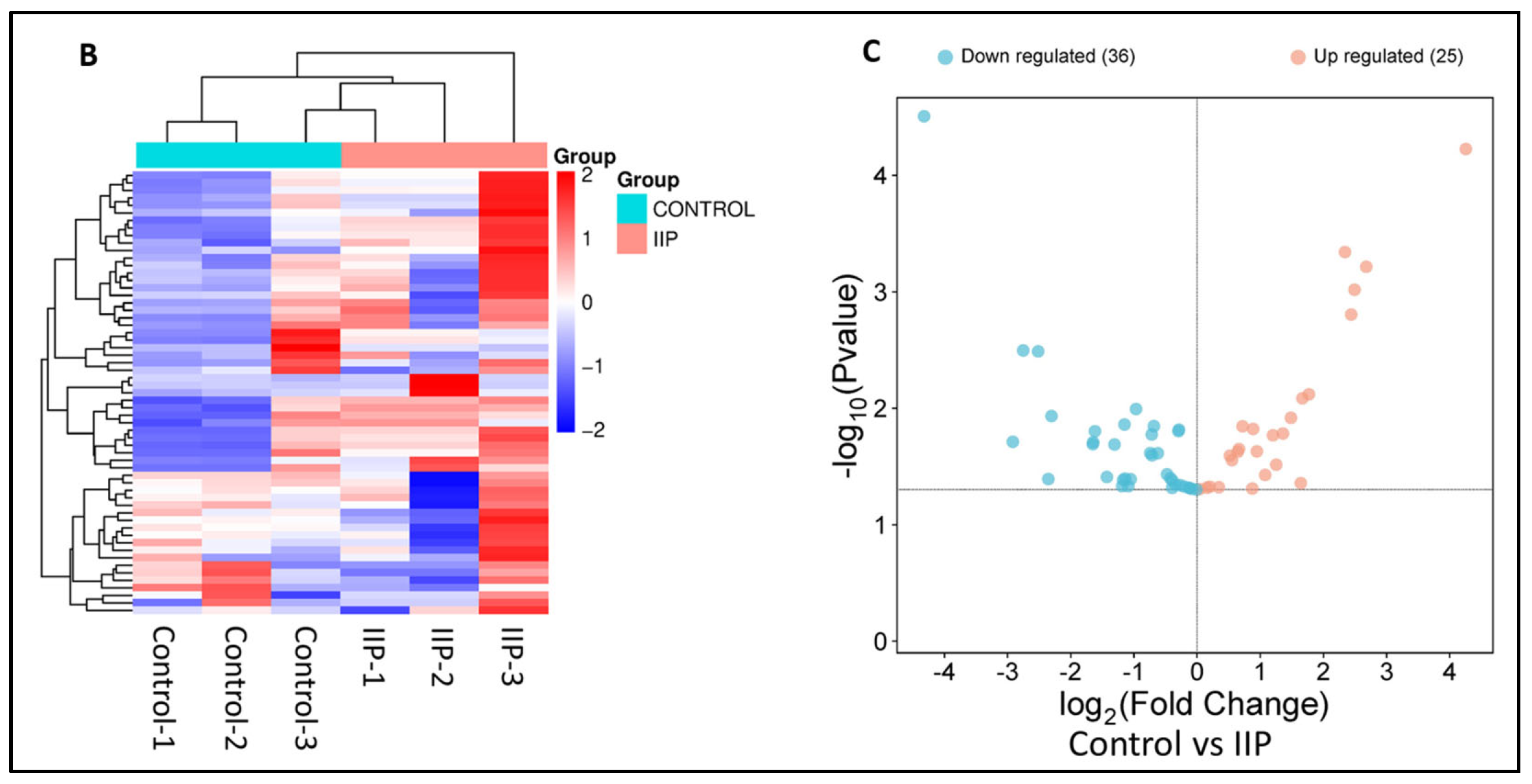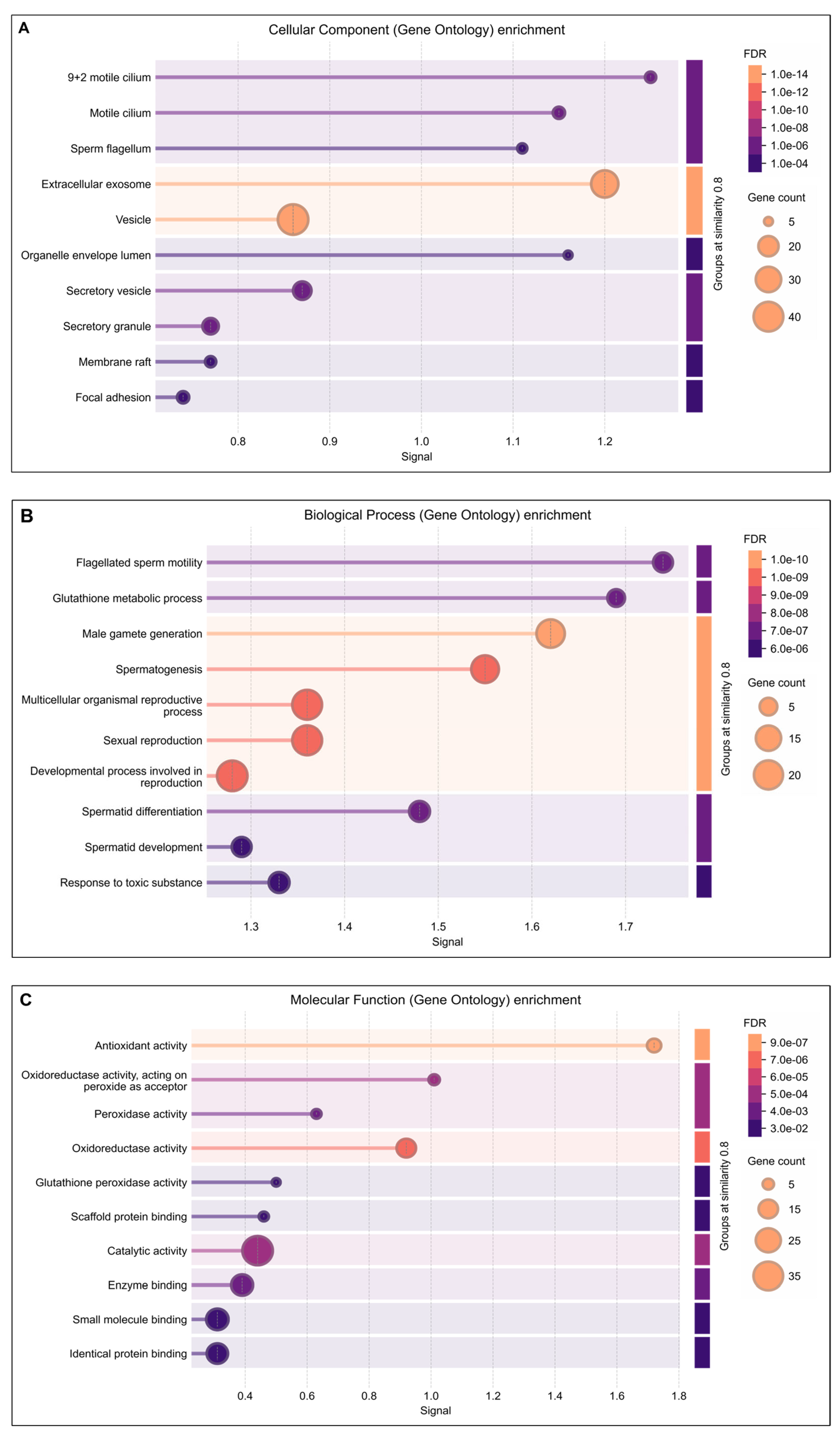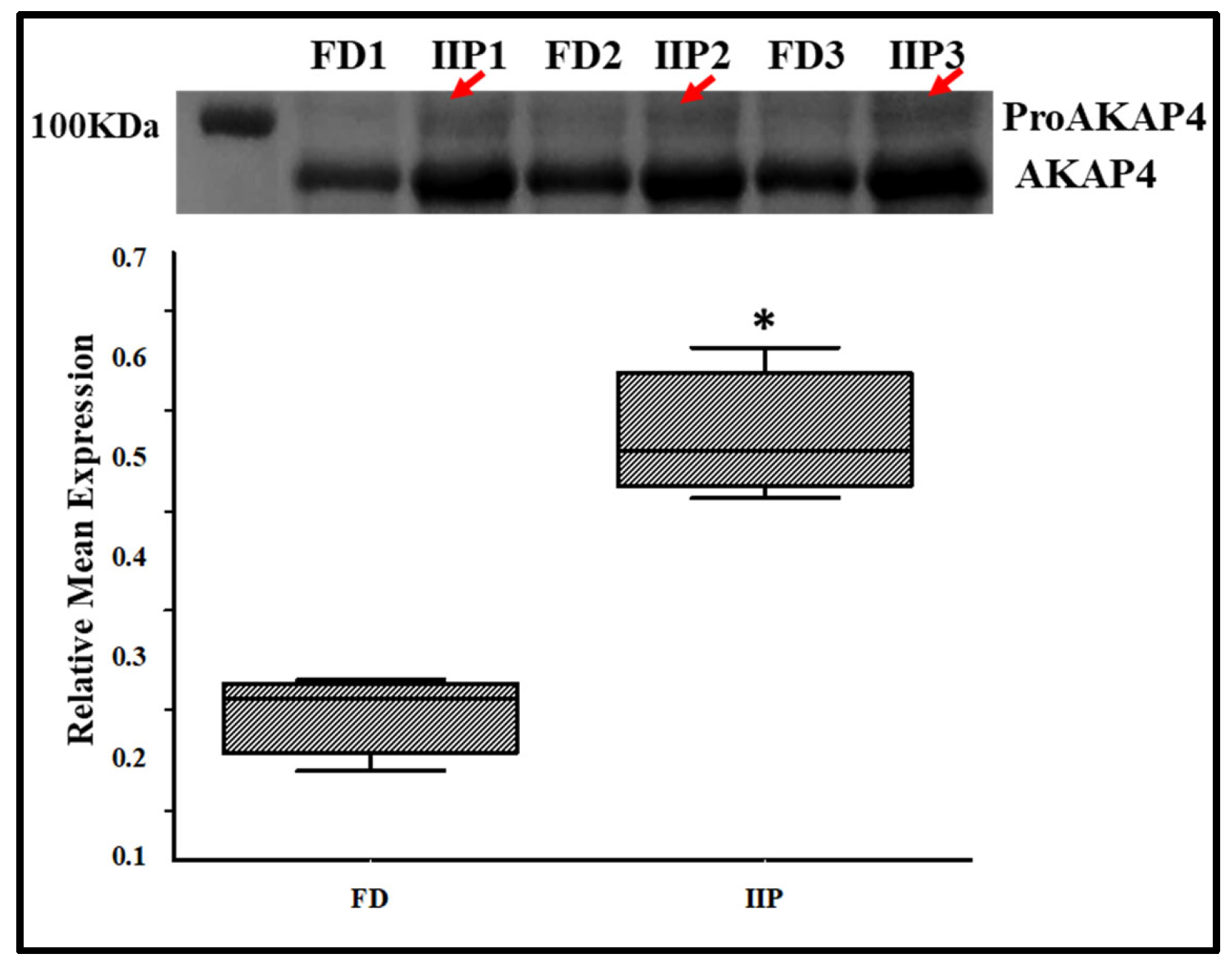Spermatozoa Proteins Involved in ROS Generation and Antioxidant Defense Are Differentially Acetylated in Idiopathic Infertility
Abstract
1. Introduction
2. Materials and Methods
2.1. Ethics Statement and Patient Selection
2.2. Sample Preparation
2.3. Sperm Protein Extraction and Tryptic Digestion
2.4. Immunoprecipitation of Lysine-Acetylated Peptides of Spermatozoa
2.5. Proteome Profiling of Immunoprecipitated Lysine Acetylated Peptides
2.6. Label-Free Quantification (LFQ) of Acetylation Sites
2.7. Bioinformatics Analysis
2.8. Protein–Protein Interaction (PPI) Network Construction and Hub Lysine Acetylated Protein Identification
2.9. Western Blotting
2.10. Statistical Analysis
3. Results
3.1. Proteomic Analysis of Lysine Acetylated Spermatozoa Proteins
3.2. Distribution Pattern and Functional Annotation of Differentially Expressed Lysine-Acetylated Proteins of Spermatozoa
3.3. Pathway Analysis of Lysine Acetylated Spermatozoa Differential Expressed Proteins
3.4. Protein–Protein Interaction Network for Identification of Lysine-Acetylated Hub Proteins
3.5. Expression Profile of Key Hub Proteins
4. Discussion
4.1. Redox Dysregulation, Antioxidant Defense, and Proteostasis
4.2. Energy Metabolism, Motility Regulation, and Structural Integrity
4.3. Key Regulatory Proteins in Redox and Metabolic Homeostasis
4.4. Epigenetic, Clinical, and Therapeutic Implications
5. Conclusions
Supplementary Materials
Author Contributions
Funding
Institutional Review Board Statement
Informed Consent Statement
Data Availability Statement
Acknowledgments
Conflicts of Interest
Abbreviations
| NOA | Non-obstructive azoospermia |
| IMI | Idiopathic male infertility |
| ROS | Reactive oxygen species |
| DEPs | Differentially expressed proteins |
| IPA | Ingenuity pathway analysis |
| GO | Gene ontology |
| KEGG | Kyoto Encyclopedia of Genes and Genomes |
References
- Goutami, L.; Jena, S.R.; Moharana, A.K.; Pradhan, A.; Kar, S.; Samanta, L. HSPA2 emerges as a key biomarker: Insights from global lysine acetylproteomic profiling in idiopathic male infertility. Cell Stress Chaperones 2025, 30, 100090. [Google Scholar] [CrossRef]
- Gosalvez, J.; Tvrda, E.; Agarwal, A. Free radical and superoxide reactivity detection in semen quality assessment: Past, present, and future. J. Assist. Reprod. Genet. 2017, 34, 697–707. [Google Scholar] [CrossRef] [PubMed]
- Wang, Z.; Li, D.; Zhou, G.; Xu, Z.; Wang, X.; Tan, S.; Li, Z.; Li, X.; Song, C.; Yuan, S. Deciphering the role of reactive oxygen species in idiopathic asthenozoospermia. Front. Endocrinol. 2025, 16, 1505213. [Google Scholar] [CrossRef]
- Dias, T.R.; Samanta, L.; Agarwal, A.; Pushparaj, P.N.; Panner Selvam, M.K.; Sharma, R. Proteomic signatures reveal differences in stress response, antioxidant defense and proteasomal activity in fertile men with high seminal ROS levels. Int. J. Mol. Sci. 2019, 20, 203. [Google Scholar] [CrossRef] [PubMed]
- O’Flaherty, C. Peroxiredoxins: Hidden players in the antioxidant defence of human spermatozoa. Basic Clin. Androl. 2014, 24, 4. [Google Scholar] [CrossRef]
- Shah, T.; Shin, D. Empiric medical therapy for idiopathic male infertility. In Male Infertility: Contemporary Clinical Approaches, Andrology, ART and Antioxidants; Springer: Berlin/Heidelberg, Germany, 2020; pp. 873–882. [Google Scholar]
- Shrivastava, N.; Shrivastava, V.; Pandey, M. A Study of Role of Reactive Oxygen Species in Idiopathic Male Infertility & Its Management by Antioxidant Therapy in Uttar Pradesh (UP). Evid. Based Med. Healthc. 2021, 8, 3023–3027. [Google Scholar]
- Kaur, M.; Ghosal, A.; Kaur, R.; Chhabra, K.; Kapoor, H.S.; Khetarpal, P. Exposure to potentially toxic elements (PTEs) and the risk of male infertility-A Systematic review and meta-analysis. J. Gynecol. Obstet. Hum. Reprod. 2024, 53, 102782. [Google Scholar] [CrossRef] [PubMed]
- Ottolenghi, S.; Rubino, F.M.; Sabbatini, G.; Coppola, S.; Veronese, A.; Chiumello, D.; Paroni, R. Oxidative stress markers to investigate the effects of hyperoxia in anesthesia. Int. J. Mol. Sci. 2019, 20, 5492. [Google Scholar] [CrossRef]
- Liu, P.; Xiao, J.; Wang, Y.; Song, X.; Huang, L.; Ren, Z.; Kitazato, K.; Wang, Y. Posttranslational modification and beyond: Interplay between histone deacetylase 6 and heat-shock protein 90. Mol. Med. 2021, 27, 110. [Google Scholar] [CrossRef]
- Guo, Z.; Ma, X.; Zhang, R.X.; Yan, H. Oxidative stress, epigenetic regulation and pathological processes of lens epithelial cells underlying diabetic cataract. Adv. Ophthalmol. Pract. Res. 2023, 3, 180–186. [Google Scholar] [CrossRef]
- Sharma, R.; Agarwal, A.; Mohanty, G.; Hamada, A.J.; Gopalan, B.; Willard, B.; Yadav, S.; Du Plessis, S. Proteomic analysis of human spermatozoa proteins with oxidative stress. Reprod. Biol. Endocrinol. 2013, 11, 48. [Google Scholar] [CrossRef]
- Clough, T.; Thaminy, S.; Ragg, S.; Aebersold, R.; Vitek, O. Statistical protein quantification and significance analysis in label-free LC-MS experiments with complex designs. BMC Bioinform. 2012, 13 (Suppl. S16), S6. [Google Scholar] [CrossRef] [PubMed]
- WHO. WHO Laboratory Manual for the Examination and Processing of Human Semen, 5th ed.; World Health: Geneva, Switzerland, 2010; p. 443. [Google Scholar]
- Sharma, R.; Biedenharn, K.R.; Fedor, J.M.; Agarwal, A. Lifestyle factors and reproductive health: Taking control of your fertility. Reprod. Biol. Endocrinol. 2013, 11, 66. [Google Scholar] [CrossRef]
- Zhou, Y.; Zhang, H.; Yan, H.; Han, P.; Zhang, J.; Liu, Y. Deciphering the Role of Oxidative Stress in Male Infertility: Insights from Reactive Oxygen Species to Antioxidant Therapeutics. Front. Biosci. Landmark 2025, 30, 27046. [Google Scholar] [CrossRef] [PubMed]
- Panner Selvam, M.K.; Samanta, L.; Agarwal, A. Functional analysis of differentially expressed acetylated spermatozoal proteins in infertile men with unilateral and bilateral varicocele. Int. J. Mol. Sci. 2020, 21, 3155. [Google Scholar] [CrossRef]
- Zhao, Q.; Zhang, Z.; Li, J.; Xu, F.; Zhang, B.; Liu, M.; Liu, Y.; Chen, H.; Yang, J.; Zhang, J. Lysine acetylome study of human hepatocellular carcinoma tissues for biomarkers and therapeutic targets discovery. Front. Genet. 2020, 11, 572663. [Google Scholar] [CrossRef]
- Yu, H.; Diao, H.; Wang, C.; Lin, Y.; Yu, F.; Lu, H.; Xu, W.; Li, Z.; Shi, H.; Zhao, S. Acetylproteomic analysis reveals functional implications of lysine acetylation in human spermatozoa (sperm). Mol. Cell. Proteom. 2015, 14, 1009–1023. [Google Scholar] [CrossRef] [PubMed]
- Marques, C.; Guo, W.; Pereira, P.; Taylor, A.; Patterson, C.; Evans, P.C.; Shang, F. The triage of damaged proteins: Degradation by the ubiquitin-proteasome pathway or repair by molecular chaperones. FASEB J. Off. Publ. Fed. Am. Soc. Exp. Biol. 2006, 20, 741. [Google Scholar] [CrossRef]
- Zhang, Y.; Wang, S.; Zhang, L.; Zhou, F.; Zhu, K.; Zhu, Q.; Liu, Q.; Liu, Y.; Jiang, L.; Ning, G. Protein acetylation derepresses serotonin synthesis to potentiate pancreatic beta-cell function through HDAC1-PKA-Tph1 signaling. Theranostics 2020, 10, 7351. [Google Scholar] [CrossRef]
- Nixon, B.; Johnston, S.D.; Skerrett-Byrne, D.A.; Anderson, A.L.; Stanger, S.J.; Bromfield, E.G.; Martin, J.H.; Hansbro, P.M.; Dun, M.D. Modification of crocodile spermatozoa refutes the tenet that post-testicular sperm maturation is restricted to mammals. Mol. Cell. Proteom. 2019, 18, S58–S76. [Google Scholar] [CrossRef]
- Pryor, W.A.; Houk, K.N.; Foote, C.S.; Fukuto, J.M.; Ignarro, L.J.; Squadrito, G.L.; Davies, K.J. Free radical biology and medicine: It’s a gas, man! Am. J. Physiol. Regul. Integr. Comp. Physiol. 2006, 291, R491–R511. [Google Scholar] [CrossRef]
- Carracedo, S.; Briand-Amirat, L.; Dordas-Perpinyà, M.; Escuredo, Y.R.; Delcombel, R.; Sergeant, N.; Delehedde, M. ProAKAP4 protein marker: Towards a functional approach to male fertility. Anim. Reprod. Sci. 2022, 247, 107074. [Google Scholar] [CrossRef]
- du Plessis, S.S.; Agarwal, A.; Mohanty, G.; Van der Linde, M. Oxidative phosphorylation versus glycolysis: What fuel do spermatozoa use? Asian J. Androl. 2015, 17, 230–235. [Google Scholar] [CrossRef]
- Agarwal, A.; Leisegang, K.; Majzoub, A.; Henkel, R.; Finelli, R.; Selvam, M.K.P.; Tadros, N.; Parekh, N.; Ko, E.Y.; Cho, C.-L. Utility of antioxidants in the treatment of male infertility: Clinical guidelines based on a systematic review and analysis of evidence. World J. Men’s Health 2021, 39, 233. [Google Scholar] [CrossRef] [PubMed]
- Aitken, R.J.; Drevet, J.R. The importance of oxidative stress in determining the functionality of mammalian spermatozoa: A two-edged sword. Antioxidants 2020, 9, 111. [Google Scholar] [CrossRef] [PubMed]
- Bach, H.A.; Vu, P.N.; Ma, T.H.T.; Nguyen, H.H.; Tran Duc, P.; Bui Minh, D.; Nong, V.H.; Nguyen, D.T. Genetic variations of antioxidant genes and their association with male infertility in Vietnamese men. J. Clin. Lab. Anal. 2023, 37, e24829. [Google Scholar] [CrossRef] [PubMed]
- Yan, L.; Liu, J.; Wu, S.; Zhang, S.; Ji, G.; Gu, A. Seminal superoxide dismutase activity and its relationship with semen quality and SOD gene polymorphism. J. Assist. Reprod. Genet. 2014, 31, 549–554. [Google Scholar] [CrossRef]
- Turnham, R.E.; Scott, J.D. Proteinkinase A catalytic subunit isoform PRKACA.; History, function and physiology. Gene 2016, 577, 101–108. [Google Scholar] [CrossRef]
- Zapata-Carmona, H.; Barón, L.; Kong, M.; Morales, P. Protein kinase a (PRKA) activity is regulated by the proteasome at the onset of human sperm capacitation. Cells 2021, 10, 3501. [Google Scholar] [CrossRef]
- Skou, L.D.; Johansen, S.K.; Okarmus, J.; Meyer, M. Pathogenesis of DJ-1/PARK7-mediated Parkinson’s disease. Cells 2024, 13, 296. [Google Scholar] [CrossRef]
- Hosseini, M.; Khalafiyan, A.; Zare, M.; Karimzadeh, H.; Bahrami, B.; Hammami, B.; Kazemi, M. Sperm epigenetics and male infertility: Unraveling the molecular puzzle. Hum. Genom. 2024, 18, 57. [Google Scholar] [CrossRef] [PubMed]
- Wang, Y.; Fu, X.; Li, H. Mechanisms of oxidative stress-induced sperm dysfunction. Front. Endocrinol. 2025, 16, 1520835. [Google Scholar] [CrossRef] [PubMed]
- Bouhadana, D.; Godin Pagé, M.-H.; Montjean, D.; Bélanger, M.-C.; Benkhalifa, M.; Miron, P.; Petrella, F. The Role of Antioxidants in Male Fertility: A Comprehensive Review of Mechanisms and Clinical Applications. Antioxidants 2025, 14, 1013. [Google Scholar] [CrossRef]
- Mojica-Villegas, M.A.; Izquierdo-Vega, J.A.; Chamorro-Cevallos, G.; Sánchez-Gutiérrez, M. Protective effect of resveratrol on biomarkers of oxidative stress induced by iron/ascorbate in mouse spermatozoa. Nutrients 2014, 6, 489–503. [Google Scholar] [CrossRef]
- Santonastaso, M.; Mottola, F.; Iovine, C.; Colacurci, N.; Rocco, L. Protective effects of curcumin on the outcome of cryopreservation in human sperm. Reprod. Sci. 2021, 28, 2895–2905. [Google Scholar] [CrossRef]
- Çolak, D.A.; Uysal, H. Protective effects of coenzyme Q10 and resveratrol on oxidative stress induced by various dioxins on transheterozigot larvae of Drosophila melanogaster. Toxicol. Res. 2017, 6, 521–525. [Google Scholar] [CrossRef]
- Agarwal, A.; Panner Selvam, M.K.; Samanta, L.; Vij, S.C.; Parekh, N.; Sabanegh, E.; Tadros, N.N.; Arafa, M.; Sharma, R. Effect of antioxidant supplementation on the sperm proteome of idiopathic infertile men. Antioxidants 2019, 8, 488. [Google Scholar] [CrossRef] [PubMed]









| Categories | Diseases or Functions Annotation | p-Value | Activation z-Score | Proteins |
|---|---|---|---|---|
| Free Radical Scavenging, Molecular Transport | Quantity of reactive oxygen species | 0.00000081 | 1.66 | AIFM1, AKR1B1, ALOX15B, APOE, APP, AQP7, ATP5PO, BCL2L1, BPNT2, CAT, DCD, EEF1G, EPHX1, FTH1, GLO1, GPX4, GSR, GSTP1, HSPA4, HSPA9, KRAS, LCN2, PARK7, PFN1, PGD, PRDX6, PREP, PRKDC, PSEN2, SOD1, UQCRFS1, VDAC3 |
| Organismal Injury and Abnormalities, Reproductive System Disease | Infertility and Asthenozoospermia | 0.0000231 | 1.387 | AKAP4, ARHGDIA, ATP1A4, ATP2B4, BGN, BSG, CA4, CFAP52, DPY19L2, ELAPOR1, H1-6, HSD17B4, HSPA4, IGF2R, KRAS, KRT8, LDHC, MNS1, NECTIN2, PITHD1, PIWIL1, PRKACA, PRKRA, RAD23B, SEPTIN4, SOD1, SPAG6, TALDO1, TEX101, TEX14, VDAC3, YWHAE, ZPBP |
Disclaimer/Publisher’s Note: The statements, opinions and data contained in all publications are solely those of the individual author(s) and contributor(s) and not of MDPI and/or the editor(s). MDPI and/or the editor(s) disclaim responsibility for any injury to people or property resulting from any ideas, methods, instructions or products referred to in the content. |
© 2025 by the authors. Licensee MDPI, Basel, Switzerland. This article is an open access article distributed under the terms and conditions of the Creative Commons Attribution (CC BY) license (https://creativecommons.org/licenses/by/4.0/).
Share and Cite
Goutami, L.; Pradhan, A.; Moharana, A.K.; Jena, S.R.; Panner Selvam, M.K.; Sikka, S.C.; Samanta, L. Spermatozoa Proteins Involved in ROS Generation and Antioxidant Defense Are Differentially Acetylated in Idiopathic Infertility. Antioxidants 2025, 14, 1410. https://doi.org/10.3390/antiox14121410
Goutami L, Pradhan A, Moharana AK, Jena SR, Panner Selvam MK, Sikka SC, Samanta L. Spermatozoa Proteins Involved in ROS Generation and Antioxidant Defense Are Differentially Acetylated in Idiopathic Infertility. Antioxidants. 2025; 14(12):1410. https://doi.org/10.3390/antiox14121410
Chicago/Turabian StyleGoutami, Lisa, Anwesha Pradhan, Ajaya Kumar Moharana, Soumya Ranjan Jena, Manesh Kumar Panner Selvam, Suresh C. Sikka, and Luna Samanta. 2025. "Spermatozoa Proteins Involved in ROS Generation and Antioxidant Defense Are Differentially Acetylated in Idiopathic Infertility" Antioxidants 14, no. 12: 1410. https://doi.org/10.3390/antiox14121410
APA StyleGoutami, L., Pradhan, A., Moharana, A. K., Jena, S. R., Panner Selvam, M. K., Sikka, S. C., & Samanta, L. (2025). Spermatozoa Proteins Involved in ROS Generation and Antioxidant Defense Are Differentially Acetylated in Idiopathic Infertility. Antioxidants, 14(12), 1410. https://doi.org/10.3390/antiox14121410






